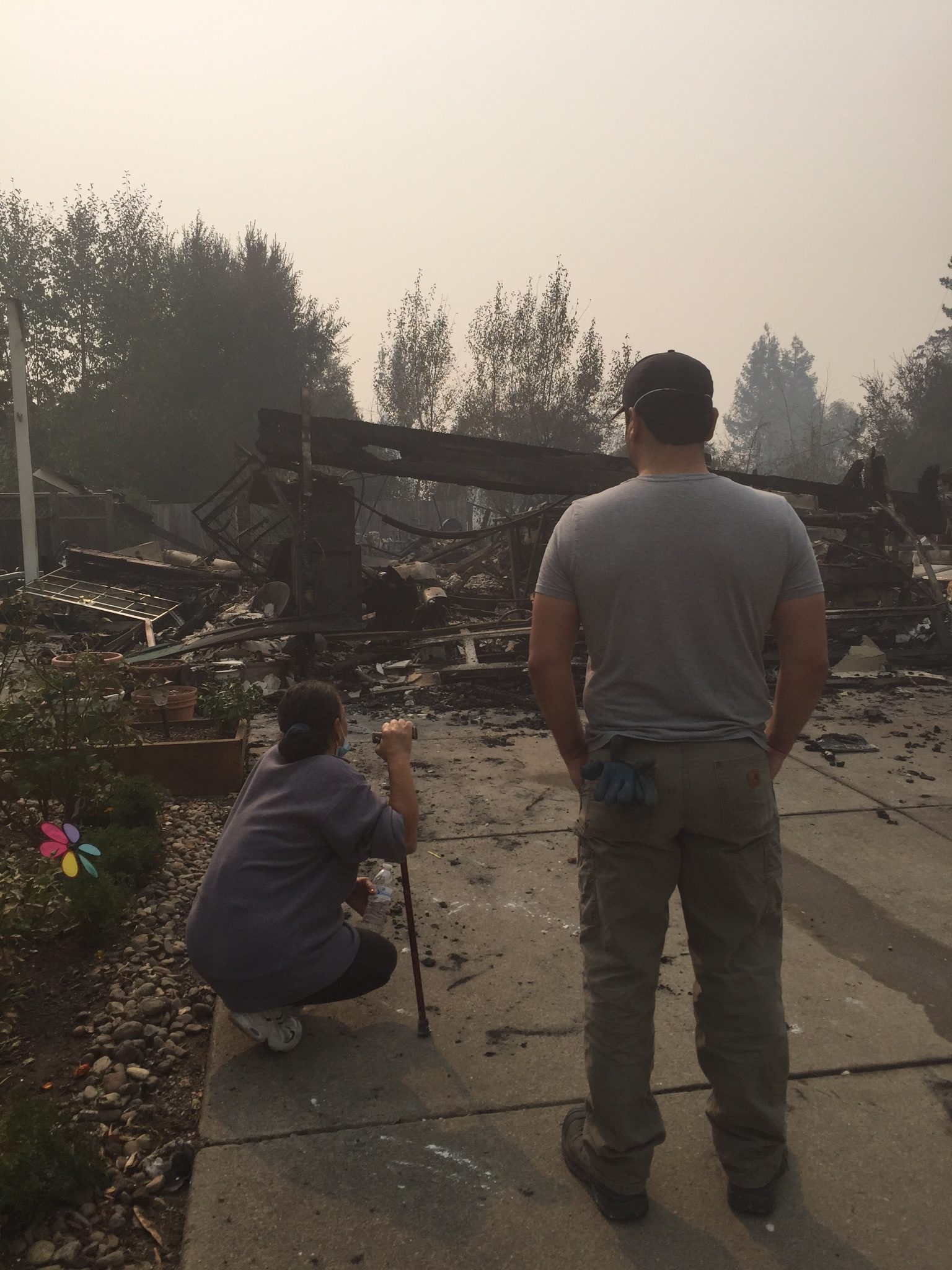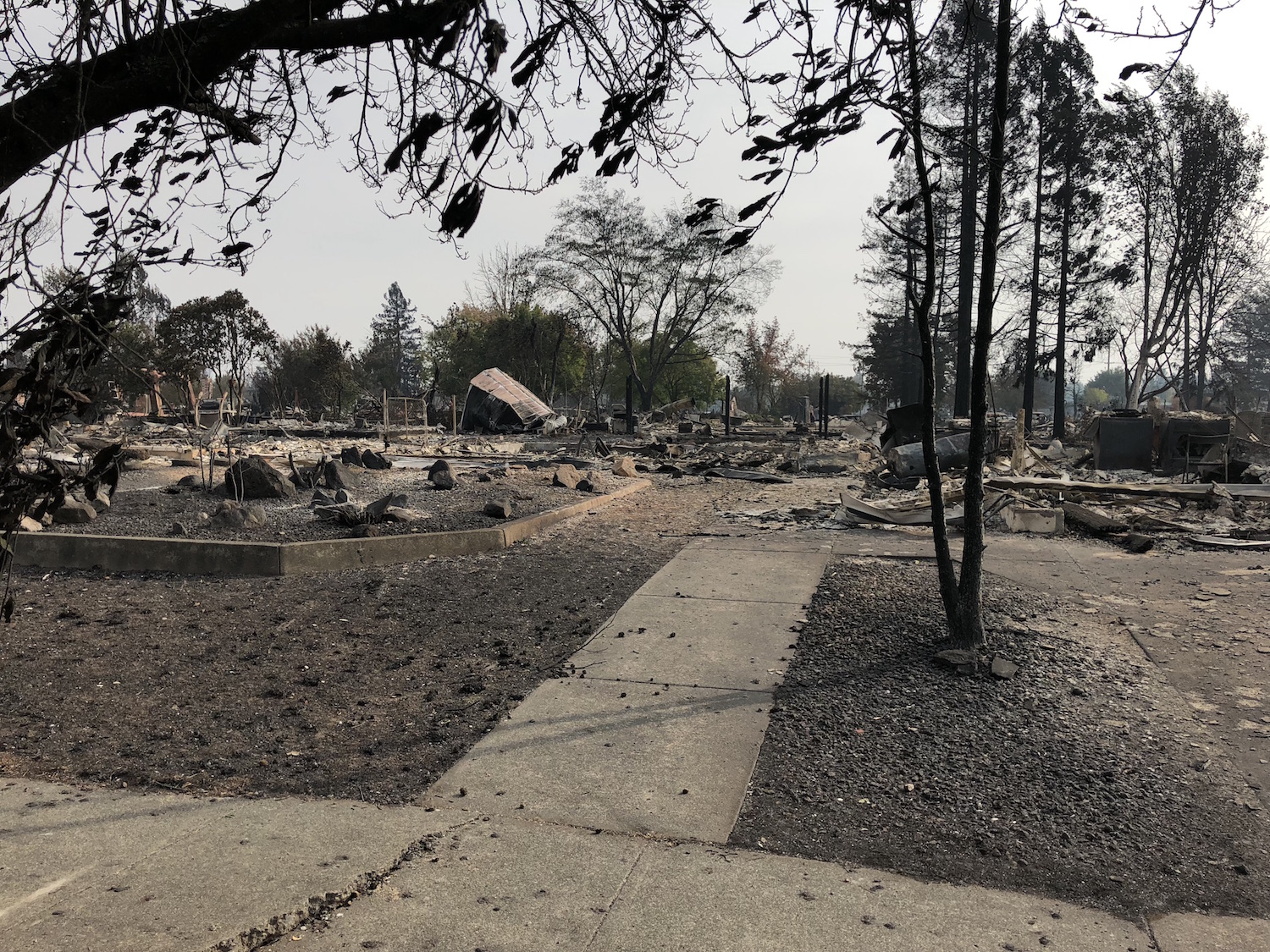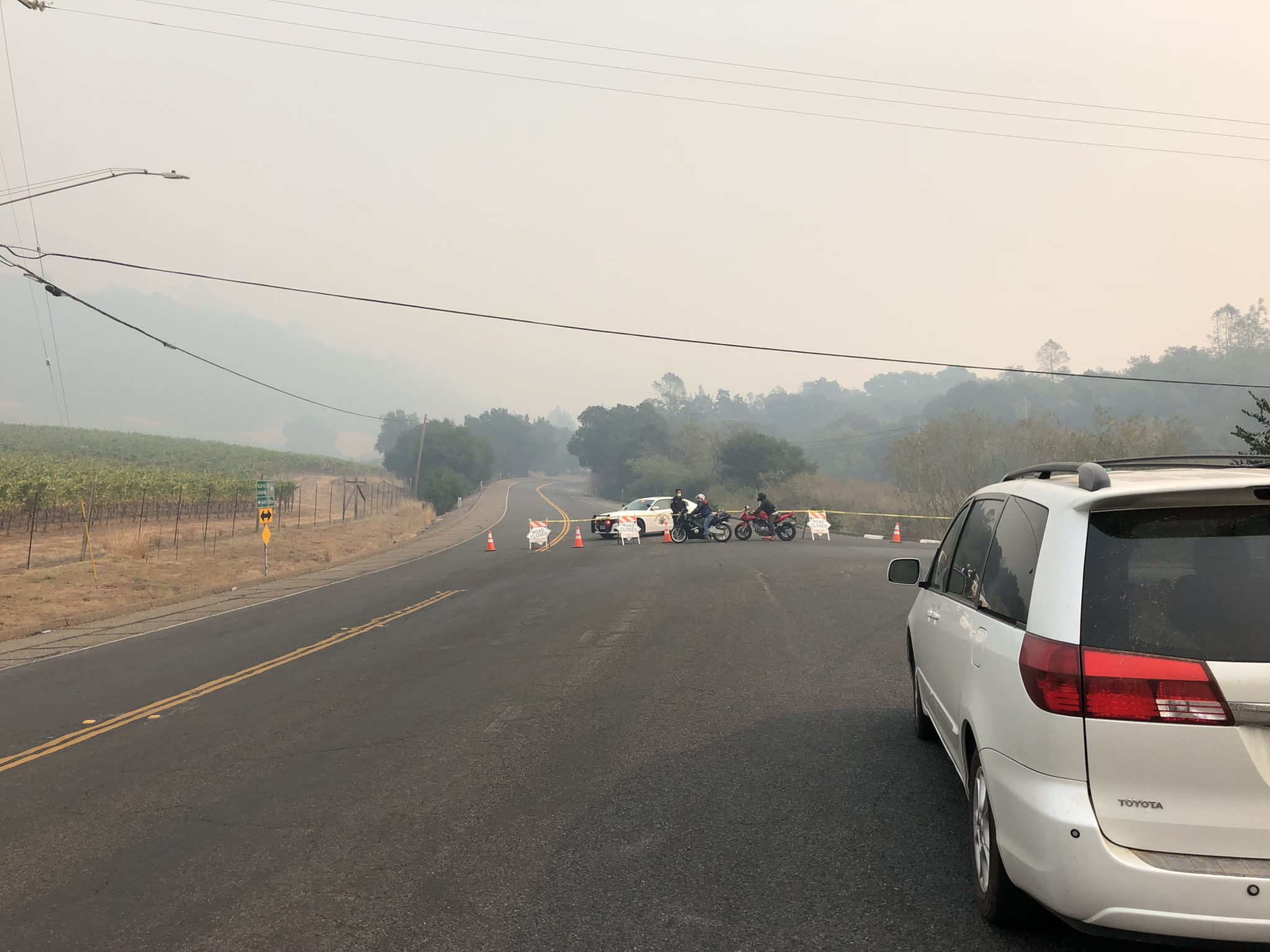SANTA ROSA, California — If you walk far enough along San Miguel road, rows of pristine houses — two cars in the driveway, a sturdy tree in the front yard — suddenly transform into a desert of charred lawns, exposed foundations, and melted cars. Solemn suburbia meets Cormac McCarthy’s The Road. It happens in a matter of feet, not miles.The first thing to know about California wine country’s wildfires is that there is nothing rural, or remote about them.“This was a wildfire in a city,” Santa Rosa Mayor Chris Coursey told NPR Tuesday morning, describing how it roared across the hills and into his city’s streets. He was not exaggerating. In Santa Rosa, a mostly suburban town of roughly 175,000 people, the aftermath litters the landscape. Destruction is largely hidden behind carefully-zoned blocks of neighborhood developments and outdoor shopping malls cluttered with high-end storefronts and coffee shops, but the permeating scent of a never-ending campfire lingers, growing acrid with odors of melting metal, home cleaning chemicals, and electricity wires as you draw nearer to the scene.In this part of Sonoma County, the wildfires have been cordoned off from the general public: Roads are blocked off and guarded by police, emergency shelters and well-intentioned volunteers are in abundance. Even much of the most toxic smoke has cleared, but a canopy of grey-white still hangs over everything, giving off a sunless pallor. It’s muted, quiet. And on its face, eerily organized.
He was not exaggerating. In Santa Rosa, a mostly suburban town of roughly 175,000 people, the aftermath litters the landscape. Destruction is largely hidden behind carefully-zoned blocks of neighborhood developments and outdoor shopping malls cluttered with high-end storefronts and coffee shops, but the permeating scent of a never-ending campfire lingers, growing acrid with odors of melting metal, home cleaning chemicals, and electricity wires as you draw nearer to the scene.In this part of Sonoma County, the wildfires have been cordoned off from the general public: Roads are blocked off and guarded by police, emergency shelters and well-intentioned volunteers are in abundance. Even much of the most toxic smoke has cleared, but a canopy of grey-white still hangs over everything, giving off a sunless pallor. It’s muted, quiet. And on its face, eerily organized. Back on San Miguel Road, a young father in a yellow and black Wu-Tang T-shirt stood in his front yard, idly spraying water from a hose. His home remained standing, unaffected save for some charred mulch near his front-door walkway. Across the street, his neighbor’s house was charred black, the fence half standing, palm trees blown out.
Back on San Miguel Road, a young father in a yellow and black Wu-Tang T-shirt stood in his front yard, idly spraying water from a hose. His home remained standing, unaffected save for some charred mulch near his front-door walkway. Across the street, his neighbor’s house was charred black, the fence half standing, palm trees blown out. He stopped for a moment, dropped the mouth of the hose into a large storage bin and let it fill. With a rake, he collected stray leaves and flammable material like dead grass and dried up potted flowers. He was partly in recovery mode and partly preparing for the next wave of wildfires, if they were to return.Cars inched by in an endless stream, each passenger rubbernecking like the last one. Two days in, the half-charred neighborhood and the outside world had come upon a routine. The passage of cars; the young father cleaning his front yard; the grey-haired woman sitting pretzel legged in her front yard, frozen in disbelief at her house burned to the ground but palm tree still standing — they all appeared oddly serene.
He stopped for a moment, dropped the mouth of the hose into a large storage bin and let it fill. With a rake, he collected stray leaves and flammable material like dead grass and dried up potted flowers. He was partly in recovery mode and partly preparing for the next wave of wildfires, if they were to return.Cars inched by in an endless stream, each passenger rubbernecking like the last one. Two days in, the half-charred neighborhood and the outside world had come upon a routine. The passage of cars; the young father cleaning his front yard; the grey-haired woman sitting pretzel legged in her front yard, frozen in disbelief at her house burned to the ground but palm tree still standing — they all appeared oddly serene. That’s not the case just a few miles in any given direction, where policemen block off roads so firemen can work in 24-hour shifts to contain more than a dozen wildfires that have killed at least 17, and destroyed more than 1,500 buildings across a combined 115,000 acres of land.“We’re packed because there are still fires pushing toward us,” said Caity Hastings, resident of small-town Windsor in Northern Sonoma County. Since Sunday evening, sudden and sporadic wildfires have tormented much of wine country, with Sonoma suffering the bulk of fatalities, accounting for 11 of the 17 confirmed deaths.
That’s not the case just a few miles in any given direction, where policemen block off roads so firemen can work in 24-hour shifts to contain more than a dozen wildfires that have killed at least 17, and destroyed more than 1,500 buildings across a combined 115,000 acres of land.“We’re packed because there are still fires pushing toward us,” said Caity Hastings, resident of small-town Windsor in Northern Sonoma County. Since Sunday evening, sudden and sporadic wildfires have tormented much of wine country, with Sonoma suffering the bulk of fatalities, accounting for 11 of the 17 confirmed deaths. Like most residents in California’s North Bay area, Hastings woke up in the dark of night Sunday to the smell and site of blazing fires. There was no warning, no time to prepare.“One of the fires started right in the field across from us,” she said. Hastings and her husband watched the firefighters come and put that fire out, only to witness another one erupt nearby.Emergency officials say a mixture of heat, dry air, and strong winds transformed the sudden wildfires into an all-consuming blaze that quickly ripped through parts of the countryside and into city and suburban areas.After a cool, windless Tuesday that afforded emergency crews an opportunity to make up some ground, Sonoma County officials warn that a warmer, windier Wednesday could bring fresh troubles.Hastings isn’t ready to evacuate her home yet, but she’s all too aware of the threats still surrounding her.“We have a sprinkler going on top of our house, we’ve got all our sprinklers running around our property, just preparing that it’s not over,” she said. Like many in Sonoma and Napa, Hastings has relied on Facebook updates from friends, neighbors and town officials to get a sense of the fire’s direction and damage.
Like most residents in California’s North Bay area, Hastings woke up in the dark of night Sunday to the smell and site of blazing fires. There was no warning, no time to prepare.“One of the fires started right in the field across from us,” she said. Hastings and her husband watched the firefighters come and put that fire out, only to witness another one erupt nearby.Emergency officials say a mixture of heat, dry air, and strong winds transformed the sudden wildfires into an all-consuming blaze that quickly ripped through parts of the countryside and into city and suburban areas.After a cool, windless Tuesday that afforded emergency crews an opportunity to make up some ground, Sonoma County officials warn that a warmer, windier Wednesday could bring fresh troubles.Hastings isn’t ready to evacuate her home yet, but she’s all too aware of the threats still surrounding her.“We have a sprinkler going on top of our house, we’ve got all our sprinklers running around our property, just preparing that it’s not over,” she said. Like many in Sonoma and Napa, Hastings has relied on Facebook updates from friends, neighbors and town officials to get a sense of the fire’s direction and damage. Southeast in the postcard wine country town of Sonoma, Allison McNeil voluntarily evacuated her home in the dead of night Sunday after seeing “flames along the ridge into Napa from our bedroom window.” She’d awoken by chance — a beeping baby monitor — but once she looked outside, she and her husband knew they should leave.On their way out of Sonoma, “we saw three fires pop up within 20 minutes of driving.”McNeil counts herself lucky her home remains standing. Pregnant and due next week, she’s waiting out the emergency in Marin with her husband’s parents. She’s scheduled to give birth at Santa Rosa’s Kaiser Permanente hospital next week, but she may have to find another hospital if things don’t improve before then.Further north on route-12 toward Glen Ellen, where fires still threaten homes, businesses and vineyards, a police officer stood behind wooden barricades, making sure that no one passed. He had a box of water and Gatorade to stay hydrated, and a mask for the smoke. His job: to tell residents they can’t pass, even to check on their home.
Southeast in the postcard wine country town of Sonoma, Allison McNeil voluntarily evacuated her home in the dead of night Sunday after seeing “flames along the ridge into Napa from our bedroom window.” She’d awoken by chance — a beeping baby monitor — but once she looked outside, she and her husband knew they should leave.On their way out of Sonoma, “we saw three fires pop up within 20 minutes of driving.”McNeil counts herself lucky her home remains standing. Pregnant and due next week, she’s waiting out the emergency in Marin with her husband’s parents. She’s scheduled to give birth at Santa Rosa’s Kaiser Permanente hospital next week, but she may have to find another hospital if things don’t improve before then.Further north on route-12 toward Glen Ellen, where fires still threaten homes, businesses and vineyards, a police officer stood behind wooden barricades, making sure that no one passed. He had a box of water and Gatorade to stay hydrated, and a mask for the smoke. His job: to tell residents they can’t pass, even to check on their home. An old man got out of his car and explained to the officer that he needed his medication. The police officer advised him to call his doctor. “Kaiser’s closed,” the old man replied. The answer remained the same.Others didn’t even get out of their car; they just drove by, rolled down their windows and asked: What about now? Still the answer was no.Most seemed resigned to the idle mundanity of waiting out an emergency. Cars lined up across the winding road surrounded by rolling hills covered in vineyards. Small circles of people popped up, gathering near their cars on the side of the road to pass the time by telling their stories of sudden escape nights earlier. They talk about friends who’ve lost everything; they talk about what they know, and more urgently, they talk about what they don’t know. They worry about their homes: Would they even know if they were gone? They keep talking because that’s all many of them can do as they wait for this sudden disaster to pass.
An old man got out of his car and explained to the officer that he needed his medication. The police officer advised him to call his doctor. “Kaiser’s closed,” the old man replied. The answer remained the same.Others didn’t even get out of their car; they just drove by, rolled down their windows and asked: What about now? Still the answer was no.Most seemed resigned to the idle mundanity of waiting out an emergency. Cars lined up across the winding road surrounded by rolling hills covered in vineyards. Small circles of people popped up, gathering near their cars on the side of the road to pass the time by telling their stories of sudden escape nights earlier. They talk about friends who’ve lost everything; they talk about what they know, and more urgently, they talk about what they don’t know. They worry about their homes: Would they even know if they were gone? They keep talking because that’s all many of them can do as they wait for this sudden disaster to pass.
Advertisement



Advertisement


Advertisement

